First, you should know that rubber process oil is produced from oil or other fossil fuels. RPO is used in synthetic and natural forms to create various products, from rubber bands to large vehicle tires. This practice material is also used to make toys and airplane tires. RPO is used when combined with other materials to make tires. The classification and types of rubber process oil depend on their uses, but in general, we can divide them into two main categories:
- Synthetic RPO
- Natural RPO
Usually, the first category is produced in countries such as Brazil, with a high score in rubber process oil, and the second category is obtained in Asia and Southeast Asia. In more detail, we can categorize Rubber Process Oil into the following three groups:
- Aromatic-based RPO
- Paraffinic-based RPO
- Naphthenic-based RPO
You should also know that rubber process oil in different types has two grades: Heavy and Light. These grades are considered based on viscosity. RPO with a viscosity of 20 to 30 is included in the light or low viscosity category. On the other hand, RPO with a viscosity of 30 to 50 will be included in the heavy or high viscosity category. Next, it is better to know that the Light RPO category is considered for cold areas, and heavy RPO is suitable for hot areas and seasons. All these things are considered advantageous when they are safe and compatible with the environment. Rubber process oil has all the necessary features for safety and compatibility with the environment. RPO is beneficial in various industries, but the highest use rate is in tire industries, and a smaller percentage will be considered for other sectors. Other RPO industries include Paints and coatings, Rubber tiles, Sponge rubber, Latex products, Hoses, Conveyor belts, and so on.
Furfural extract or Process Oil has solubility, thermal stability, and color stability, which uses RPO in products such as slippers, LPG pipes, molded products, and floor tiles, so it can be said that these materials are used everywhere. Polynuclear aromatic composition is process oil in rubber compounds, incredibly aromatic rubbers. Rubber process oil is compatible with aromatic rubbers but contains less toxic polynuclear aromatic compounds than conventional aromatic RPO. Now, in this article, we will describe the types of rubber process oil, which include the following:
- Mild Extracted Solvate (MES)
- Residual Aromatic Extract (RAE)
- Treated Residual Aromatic Extract (TRAE)
- Aromatic Extract RPO
- Treated Distillate Aromatic Extracted (TDAE)
- Distillate Aromatic Extract (DAE)
- Low Viscosity RPO
- High Viscosity RPO
- Low Viscosity Paraffinic RPO
- High Viscosity Paraffinic RPO
- Naphthenic Rubber Process Oil
- Paraffinic rubber process oil
- Aromatic rubber process oil
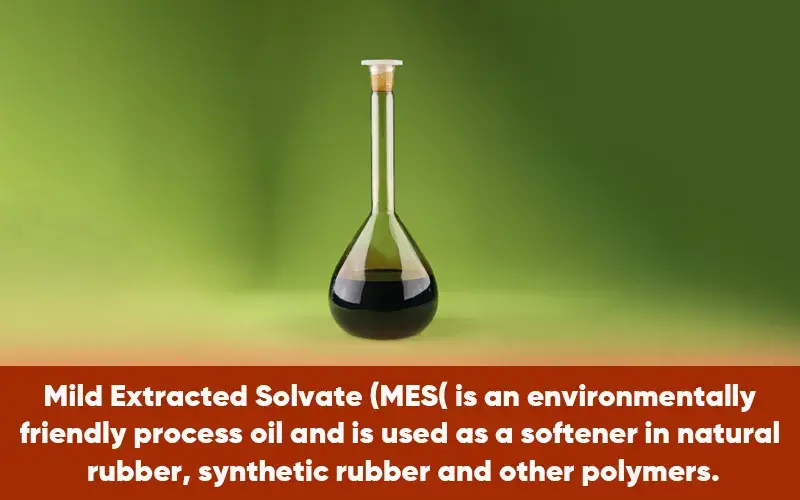
Mild Extracted Solvate (MES)
Mild Extracted Solvate (MES) is used to improve the process of rubber compounds or increase rubber volume to reduce costs. We can divide them into three main categories: aromatics, paraffinic, and naphthenic. These materials are used in chemical and manufacturing industries. Mild Extracted Solvate (MES) is safe and environmentally friendly. Rubber compounds contain little PCA oils. MES, heavy naphthenic oils, and TDAE are better than DAE. They have higher amounts of SBR STYRENE and approach a composition similar to TG. MES is environmentally friendly and is used as an extender, softener, and general processing aid in natural rubber, synthetic rubber, and other polymers. This product is used in the following cases:
- Tire Retreading
- Belt Manufacturing and Belting
- Tire Manufacturing
- Molding
- Extruding tubing and hoses
- Fertilizers
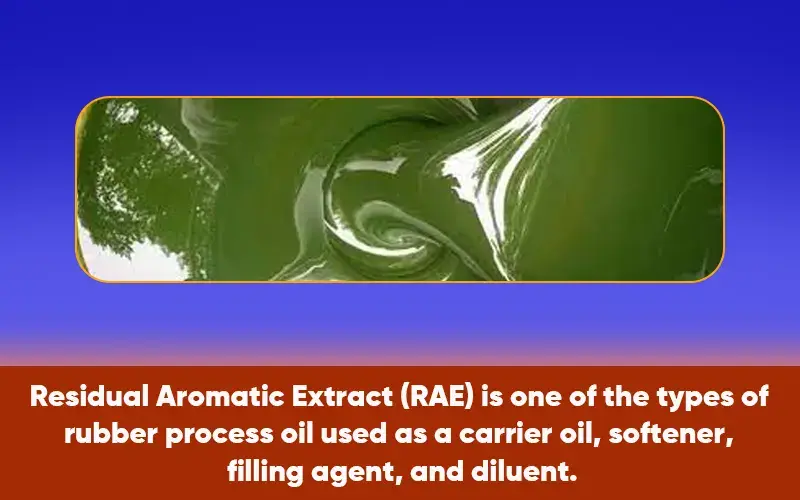
Residual Aromatic Extract (RAE)
Residual Aromatic Extract (RAE) is an aromatic process oil with high viscosity. Residual Aromatic Extract (RAE) is used as an oil extender in rubber. Polycyclic Aromatic Hydrocarbon less than 1 ppm and total PAH less than 10 ppm. This product is one of the types of rubber process oil and is used as a carrier oil, softener, filling agent, and diluent. RAE has dramatically contributed to the improvement of product performance in the rubber industry. Among the essential features of RAE, the following can be mentioned:
- Following international standards
- Increasing the life of rubber
- Solubility properties
- Improving the processing ability of rubber in grinding and mixing
- Production of the low amount of waste in this process
- Good wear resistance
- Good flexibility at low temperature
- Good rebound resistance
- Save fuel and energy
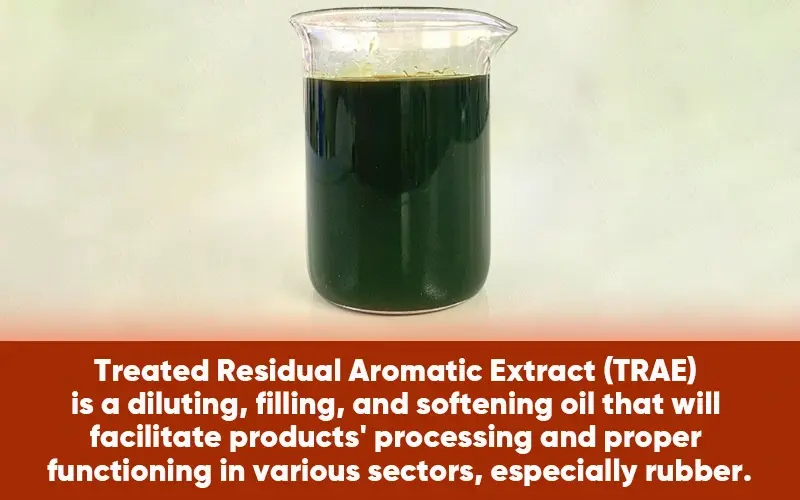
Treated Residual Aromatic Extract (TRAE)
Treated Residual Aromatic Extract (TRAE) is an environmentally friendly aromatic oil that is left over from the solvent extraction process of vacuum distillation. This product contains polycyclic compounds or PACs. Treated Residual Aromatic Extract (TRAE) has many applications in the tier, rubber, and tape industries. This product is a diluting, filling, and softening oil that will facilitate products’ processing and proper functioning in various sectors, especially rubber. Its advantages include the following:
- Good rebound resistance
- Save fuel and energy
- By international standards
- abrasion resistance
- Production of small amounts of waste in this process
- Good flexibility at low temperature
TRAE is also used in products of the following industries:
- Tires and tubes
- Battery containers
- Carrier oils
- Plastic
- Extruded products
What is rubber processing Oil used for?
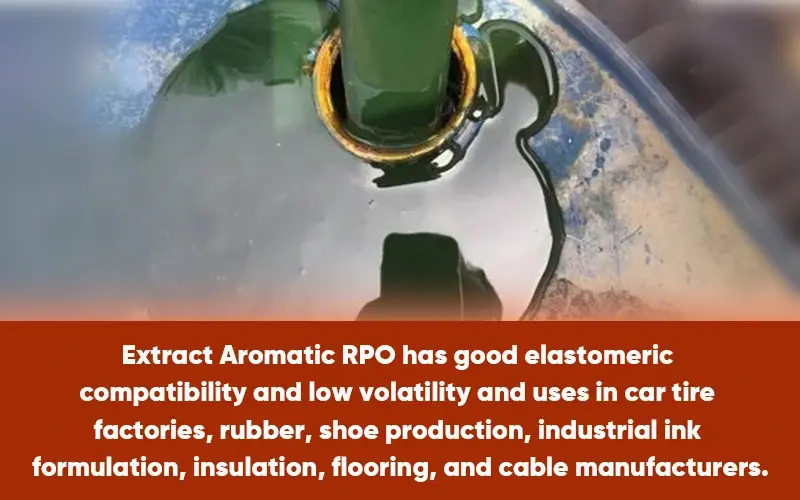
Extract Aromatic RPO
Extract Aromatic RPO is an aromatic by-product of the solvent extraction process, which is considered to improve the physical properties of vulcanization and reduce the cost of the final product. Extract Aromatic RPO has good elastomeric compatibility and low volatility. We use this product in car tire factories, rubber, shoe production, industrial ink formulation, insulation, flooring, and cable manufacturers. Usually, this product is categorized into 180 kg barrels, ISO tanks, Flexi tanks, and new bulk shipments.
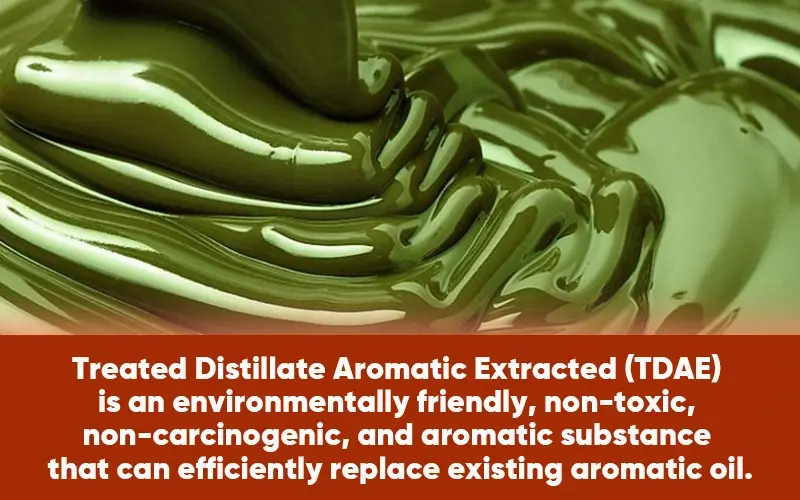
Treated Distillate Aromatic Extracted (TDAE)
Treated Distillate Aromatic Extracted (TDAE) is one of the types of rubber process oil with very high aromatic content. The high viscosity-gravity constant of TDAE has made this product be used in tire production applications. This product reduces heat accumulation. TDAE is used as an elastic softening agent during the rubber vulcanization process. High gravity has made this product extremely strong in rubber production applications. In this situation, this product helps to reduce the heat generation process. TDAE is an environmentally friendly, non-toxic, non-carcinogenic, and aromatic substance that can efficiently replace existing aromatic oil. Very high functional features have made this material be used in producing high-quality tires. This product is used in the following cases:
- As a lubricant
- As an ingredient in some engine oils, gears, and lubricants
- As a processing aid in the production of natural and synthetic rubber products
- Used in a car tire factory
- In the formulation of industrial ink
- Used in rubber production
- Used in shoes
- Used in cables
- Used in flooring
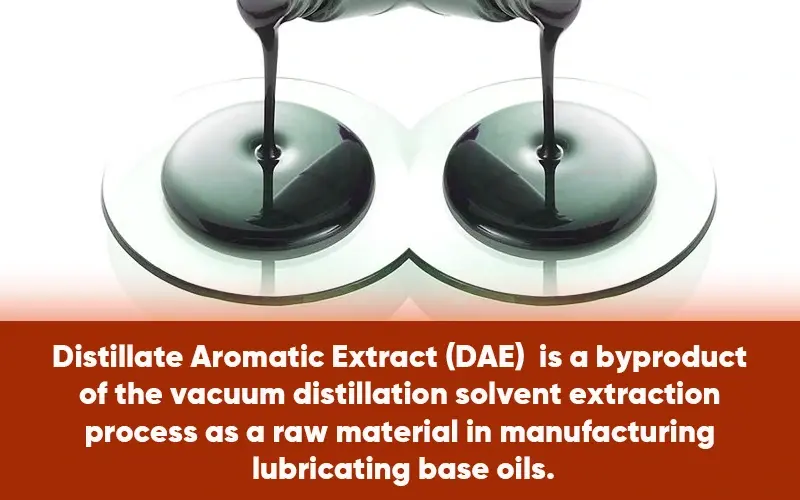
Distillate Aromatic Extract (DAE)
Distillate Aromatic Extract, an aromatic oil, contains many aromatic cycles in its composition. DAE has a very high aromatic content. DAE is a byproduct of the vacuum distillation solvent extraction process as a raw material in manufacturing lubricating base oils. Interestingly, DAE components are sparingly soluble in water and highly hydrophobic. Meanwhile, some types of this material evaporate quickly. DAEs are typically found in sediments and soil; some lighter components are airborne. DAE, which is one of the types of rubber process oil, will be used in the following applications:
- Heavy fuels
- Oil fields and resins
- Storage of feed for black carbon production
- Production of rubber and plastic carrier oils
- Diluents and fillers
- Ability to process rubber in grinding and mixing
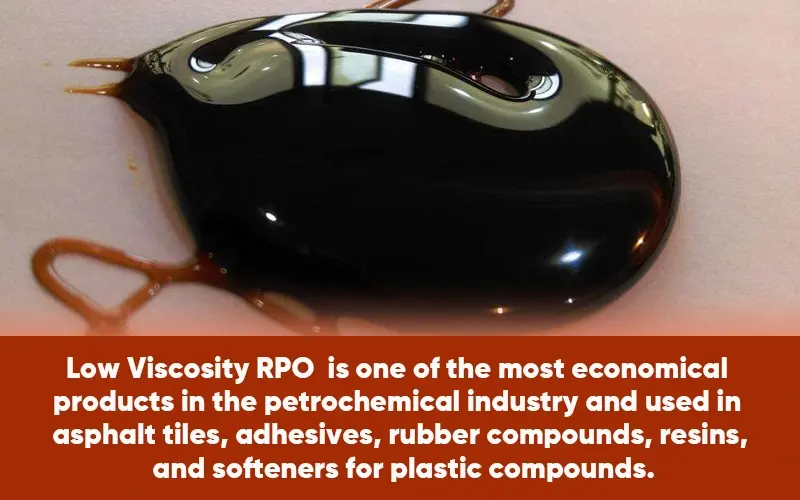
Low Viscosity RPO
Low Viscosity RPO has deficient processing during milling, mixing, and extruding operations. This material is one of the most economical products in the petrochemical industry. This material is used in tires and mechanical goods. This product has a perfect consistency and low volatility. This material is used in asphalt tiles, adhesives, rubber compounds, resins, and softeners for plastic compounds. It is interesting to know that each 20-foot container of this product, which is the type of rubber process oil, takes 80 barrels of rubber process oil with low viscosity. According to the obtained results, this product has very high quality.
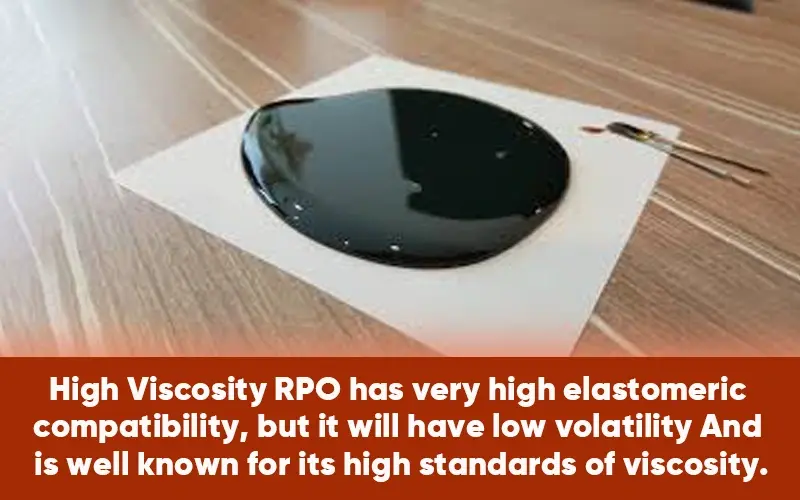
High Viscosity RPO
High Viscosity RPO is a wholly aromatic product of the solvent extraction process, which is considered to improve the physical properties of Vulcanization and reduce the cost of the final product. This functional product has very high elastomeric compatibility, but it will have low volatility. High Viscosity RPO is well known and has a high standard due to its viscosity. This product will be used in the following cases:
- Battery compartment
- Flooring materials
- car tire
- Containers
- Extruded products
- Tire Re-Treading Materials
- Wire and cable cover
- Rubber bumper
- Tires for two-wheeled shoes
- Industrial hoses
High Viscosity RPO is stable in environmental conditions, and you can store it in steel containers. The storage temperature of this product should be appropriate in all cases. It is better to know that the storage conditions are such that all packages must be kept away from all kinds of environmental pollutants, such as dust.
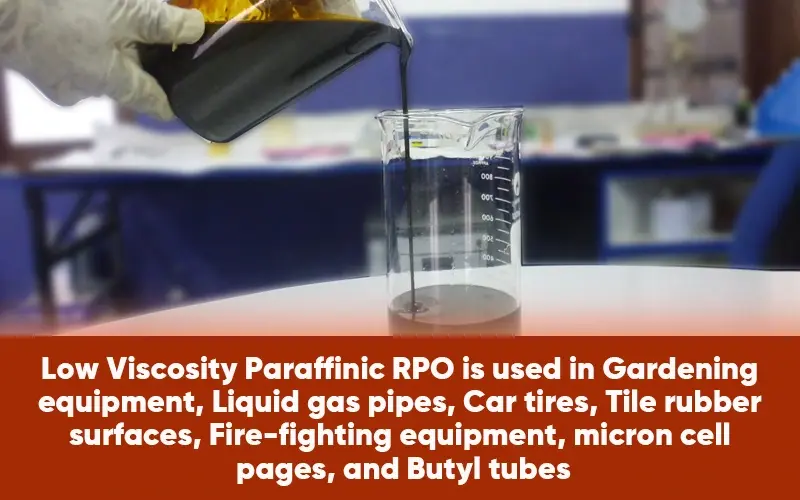
Low Viscosity Paraffinic RPO
Low Viscosity Paraffinic RPO is light brown and contains less than 3% aromatics. This product is named Green RPO because it is environmentally friendly. It is one of the most valuable products you can use in different industries. This substance is used in the following cases:
- Gardening equipment
- Liquid gas pipes
- Car tires
- Tile rubber surfaces
- Fire-fighting equipment
- micron cell pages
- Butyl tubes
This product is packed in new or second-hand 180 kg barrels, bulk shipments, ISO tanks, and Flexi tanks.
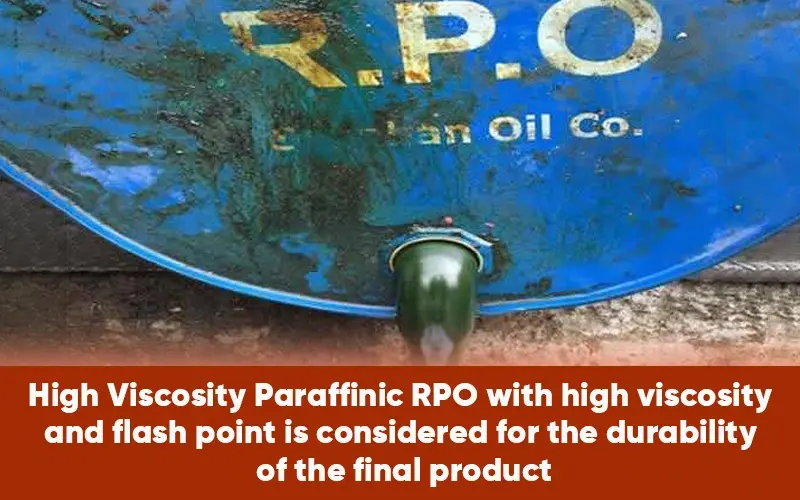
High Viscosity Paraffinic RPO
High Viscosity Paraffinic RPO forms branched or straight-chain hydrocarbon molecules with different viscosities. Increasing the length of specified chains increases viscosity, and rubber process oil becomes more viscous. This product with high viscosity and flash point is considered for the durability of the final product. This product has many applications in various industries; Some of these uses are as follows:
- Battery compartment
- Containers
- Extruded products
- Wire and cable cover
- Shoe industry
- Flooring materials
- Tires
- Rubber bumper
- Industrial hoses
- car tire
- Rubber bumper
- Tires for two-wheeled shoes
- Tire Re-Treading Materials
- Industrial hoses
This product has good color stability, solubility, and thermal stability. Also, this application material is suitable for LPG pipes, molded products, slippers, and floor tiles.
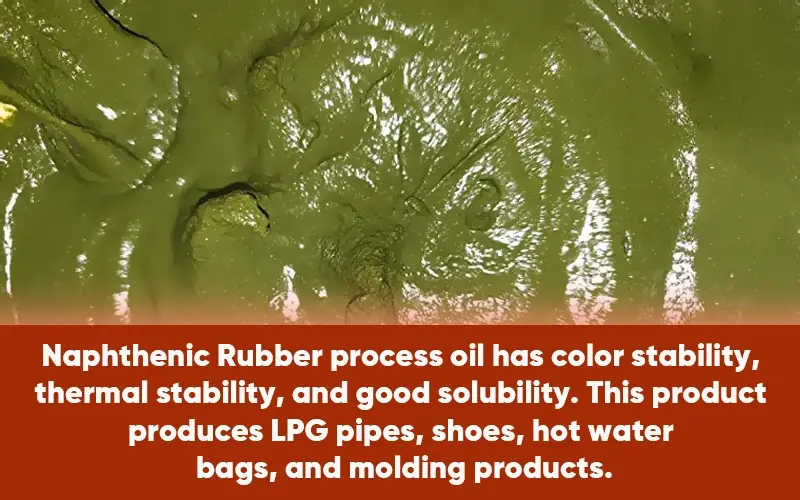
Naphthenic Rubber Process Oil
Naphthenic Rubber Process Oil is one of the types of rubber process oil with light color and non-staining compounds. This practical product has excellent compatibility with synthetic elastomers, thermal stability, greater solubility than paraffin oils, and low viscosity. This product is used as a metalworking fluid. This substance establishes a balance between two bodies by lubrication. Naphthenic Rubber process oil has color stability, thermal stability, and good solubility. This product produces LPG pipes, shoes, hot water bags, and molding products. It is also likely to be used as a lubricant in the rubber industry.
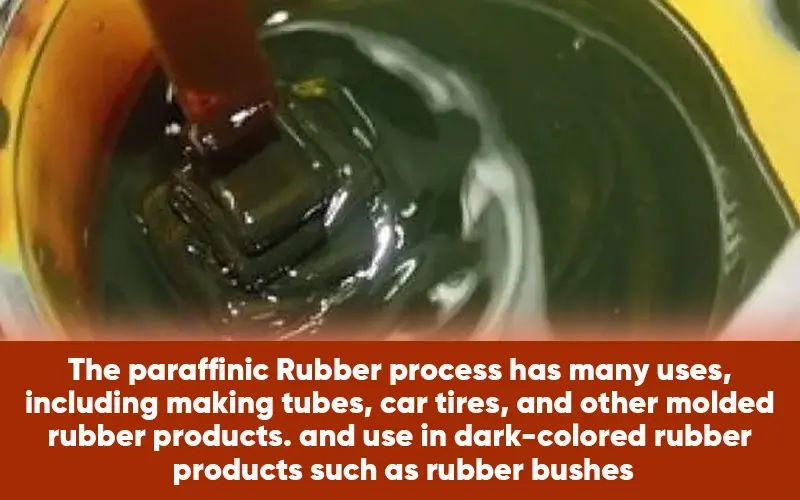
Paraffinic rubber process oil
Paraffinic Rubber process oil is considered for making all kinds of rubber products from natural and synthetic rubber. This product has many uses, including making tubes, car tires, and other molded rubber products. Also, this material is used in dark-colored rubber products such as rubber bushes, battery bodies, etc. This product is one of the types of rubber process oil with many uses in various industries.
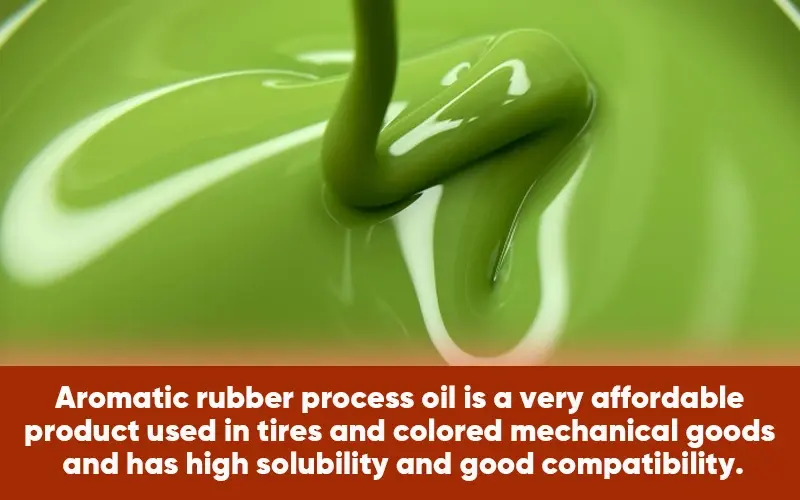
Aromatic rubber process oil
Aromatic rubber process oil is one of the types of rubber process oil with three applications. Low, medium, and high viscosity are among this material’s most widely used types. This material has a very rich aromatic with good elastomeric compatibility and is an aromatic process oil with low volatility. This material is known based on viscosity and according to world standards. Processing of this functional material is easy during grinding, mixing, and extruding operations. Aromatic rubber process oil is a very affordable product used in tires and colored mechanical goods. This product has high solubility and good compatibility.
Summary of the article types of rubber process oil
In this article, we have talked about types of rubber process oil. Rubber process oil is placed in different categories according to the kind of use. Also, these categories can vary from general to detailed. In this article, you will get to know the types of rubber process oil and get comprehensive information about them. The petrochemical industry is one of the most used industries in our lives today. You should know that process oil is used in naphthalene, paraffin, and other aromatic compounds of various molecular weight distribution. Also, these materials will be considered in the production of rubber products. These functional materials are regarded as lubricants or softeners in industrial compounds.
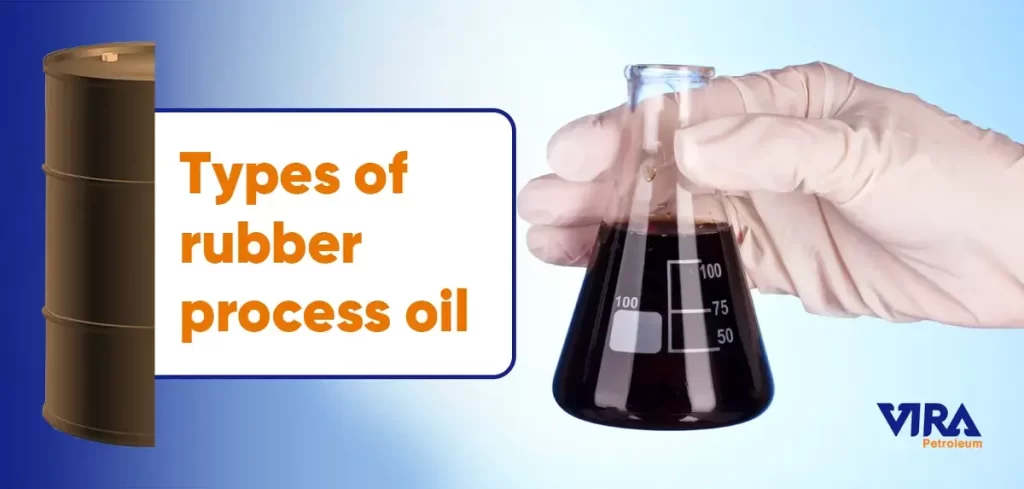

Pehuliar article, totally what I was looking for.
Thank you for your comment! I’m glad the article met your expectations and provided the information you were looking for. If you have any more specific queries or need further assistance, feel free to let me know.
Very useful information and well discribe and differnciat for different process oil.
Thank you for your feedback! I’m glad you found the information useful and that it provided a clear distinction for different types of process oils. If you have any more questions or need further assistance, feel free to ask.